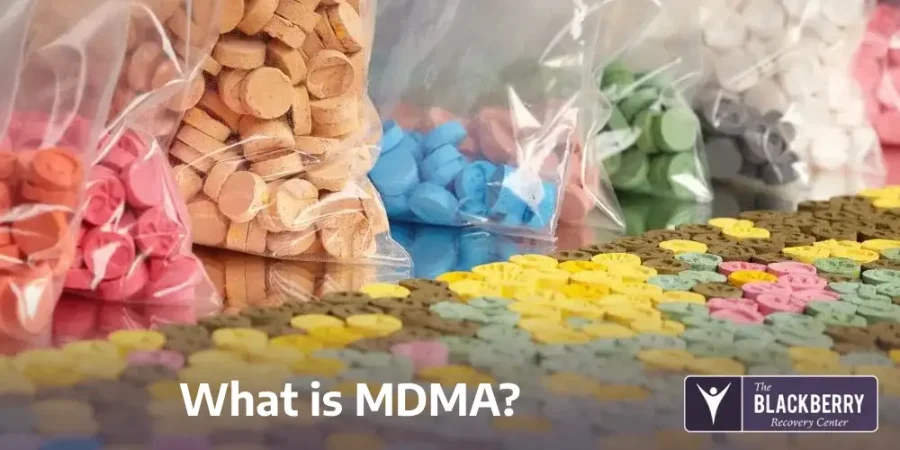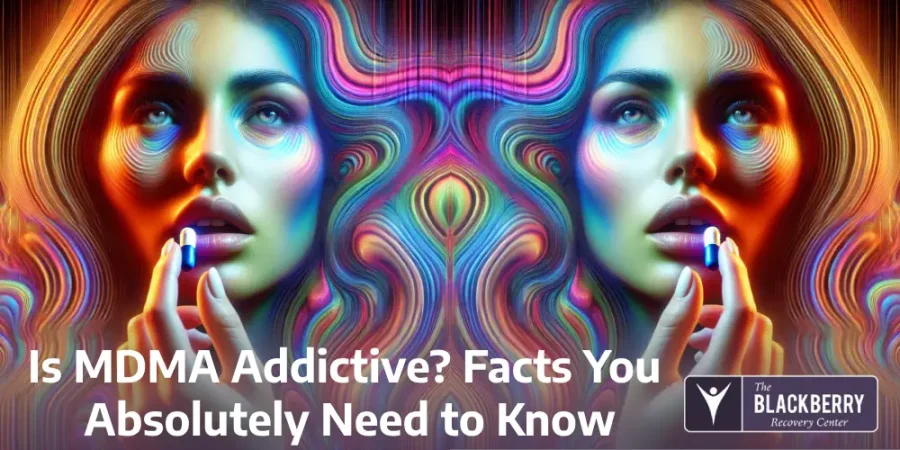Picture someone you care about at a music festival. The atmosphere is electric, the crowd pulsating to the beat. They’re offered a substance known commonly as MDMA, Molly, or Ecstasy.
As someone who cares about their well-being, you can’t help but wonder: “Could this be the start of an addiction?” If this question has crossed your mind, you’re far from alone. In this comprehensive guide, we delve deep into the complex world of MDMA.
We’ll explore its history, its various forms, and its psychological and physiological effects. Our aim is to provide a thoroughly researched answer to the unsettling question: “Is MDMA addictive?”
By the end of this guide, you’ll have a well-rounded understanding of Ecstasy, its potential addictive properties, and the options available for treatment and rehabilitation.
What is MDMA?

What is MDMA
MDMA, or 3,4-Methylenedioxymethamphetamine, is a synthetic compound that has both stimulant and hallucinogenic properties. Although it was first synthesized in 1912 by the German pharmaceutical company Merck, the compound initially found little practical use. It wasn’t until the 1970s that it gained notoriety as a substance with psychotherapeutic potential.
According to Michael Pollan’s book, “How to Change Your Mind,” Alexander Shulgin wasn’t just synthesizing MDMA for the sake of scientific curiosity. He collaborated with therapists who administered the compound, often referred to as “Ecstasy” in this context, to patients in controlled therapeutic settings.
These sessions were particularly promising for individuals suffering from Post-Traumatic Stress Disorder (PTSD), severe anxiety, and treatment-resistant depression. For example, one groundbreaking study showed that 68% of PTSD patients who underwent MDMA-assisted psychotherapy reported significant reductions in symptoms, compared to only 25% in the placebo group.
These therapeutic sessions often led to profound emotional insights and a newfound sense of connection with others, offering a transformative experience that traditional therapy couldn’t always provide. However, the drug’s growing popularity in nightclubs and among recreational users led to increasing safety concerns. Alarm bells started ringing about its potential for abuse and adverse effects, which eventually led to its criminalization in many countries. This shift cast MDMA into a realm of both medical promise and social controversy.
Today, the drug is undergoing a bit of a renaissance, with renewed scientific interest in its potential therapeutic applications.
Forms of MDMA
The nomenclature surrounding MDMA can be a bit confusing for the uninitiated. While the compound itself remains consistent, the form it takes can vary.
“Molly” is the colloquial term for the chemicals in its pure powder or crystalline form. “Ecstasy,” on the other hand, usually refers to the pressed pill form of the drug, which can contain not just ecstasy but also a medley of other substances—from caffeine to more dangerous adulterants like amphetamines or opioids.
How Long Does MDMA Last?
Once ingested, the effects of MDMA manifest within 30 to 45 minutes, peaking around 60 to 90 minutes. The overall experience can last between 3 to 6 hours. However, this duration can be influenced by several factors, such as the dosage taken, the user’s body chemistry, and the presence of other substances in the system.
How Long Does MDMA Stay in Your System?
The body metabolizes MDMA relatively quickly, but traces of the substance can linger. Standard urine tests can typically detect Ecstasy for up to 3 to 4 days after usage. However, this window can vary depending on individual metabolic rates, overall health, and frequency of use.
Microdosing MDMA
In recent years, the concept of microdosing MDMA has gained traction, especially among professionals in high-stress industries and those advocating for alternative mental health treatments. The idea is to ingest a fraction of what’s considered a recreational dose, usually around 10 to 20 milligrams. The goal is not to achieve the euphoric high associated with larger doses, but rather to unlock emotional availability and heightened creativity.
While microdosing may sound appealing, it’s crucial to note that the long-term effects are not yet fully understood. Some research suggests that even at low doses, Ecstasy could potentially affect serotonin levels in the brain, leading to mood fluctuations and other unknown long-term impacts.
Is MDMA Addictive?

Is MDMA Addictive?
One of the most pressing questions surrounding MDMA is its potential for addiction. While some argue that the drug’s effects—heightened sensations, emotional openness, and a sense of euphoria—make it ripe for abuse, the scientific community offers a more nuanced perspective.
Exploration of Addictive Properties
MDMA primarily affects neurotransmitters in the brain like serotonin, dopamine, and norepinephrine. These neurotransmitters are integral to mood, emotion, and reward pathways, which is why the drug can produce feelings of happiness and closeness. However, this also raises questions about its potential for addiction.
It’s essential to differentiate between physical and psychological addiction. Unlike substances like opioids or alcohol, Ecstasy has a lower potential for physical dependency. However, the emotional highs it provides can lead to a form of psychological dependency, where users may find themselves taking the drug to escape emotional lows or social anxieties.
Scientific Studies and Statistics
Research on MDMA’s addictive potential is still in its infancy but has been increasing in recent years. Studies have shown that while the drug doesn’t produce withdrawal symptoms commonly associated with substances like alcohol or opioids, it can lead to cravings and habitual use, especially among frequent users.
Data from the National Institute on Drug Abuse indicates that about 13% of young adults in the United States have tried Ecstasy at least once, with 2% reporting usage in the past month. While these statistics don’t directly point to widespread addiction, they do underline the drug’s prevalence and the importance of further research into its addictive properties.
Is MDMA the Same as Ecstasy?

Is MDMA the Same as Ecstasy?
This is a question that often comes up in discussions about MDMA, and the answer is both yes and no. While the terms are frequently used interchangeably, there are distinctions that are important to understand.
Brief Discussion on Commonalities and Differences
At its core, both Molly and Ecstasy are rooted in MDMA. However, while Molly is often marketed as the “pure” form of MDMA in a crystalline or powdered form, Ecstasy usually refers to the pill version that can contain a range of other substances. These additives can include anything from caffeine and other stimulants to more harmful substances like amphetamines or even opioids.
The point here is that while both forms are derived from MDMA, Ecstasy’s additional components can drastically alter the drug’s effects and risks. This is why some users prefer Molly, believing it to be purer and therefore safer. However, it’s worth noting that without proper testing, it’s impossible to be sure of the purity of any form of MDMA.
Other Common Questions About MDMA
Given the complex nature of MDMA and its varying forms, it’s natural to have additional questions. In this section, we address some of the most frequently asked questions that go beyond its addictive properties.
Is MDMA a Sex Drug?
While MDMA is not explicitly a “sex drug,” it is often associated with heightened sensory perception and emotional closeness, which can enhance sexual experiences for some people. However, it’s crucial to note that it can also have the opposite effect, such as causing erectile dysfunction in men.
Is MDMA Ecstasy?
As mentioned earlier, MDMA is the primary ingredient in what is commonly referred to as Ecstasy. However, Ecstasy often contains other substances, making it a less “pure” form of the drug.
The Science Behind MDMA

The Science Behind MDMA
To fully grasp the multifaceted effects of MDMA, it’s essential to explore the underlying science that governs how this drug interacts with the human brain and body.
How MDMA Affects the Brain
MDMA operates by influencing the brain’s neurotransmitter systems, primarily targeting serotonin, dopamine, and norepinephrine. These neurotransmitters play a pivotal role in regulating mood, energy, and social behavior. Ecstasy stimulates the release of these neurotransmitters and also inhibits their reuptake. This dual action leads to an accumulation of these chemicals in the brain’s synapses, resulting in heightened emotional and sensory experiences.
But it’s not all euphoria and bonding; this surge in neurotransmitters is often followed by a depletion, which can lead to what users commonly refer to as “comedowns,” characterized by feelings of depression, irritability, and fatigue.
Long-Term and Short-Term Effects
Short-Term Effects
- Euphoria: One of the most immediate effects is a profound sense of happiness or euphoria, which is largely due to the spike in serotonin levels.
- Increased Energy: The increase in dopamine and norepinephrine contributes to heightened energy and alertness, often making users feel invigorated.
- Enhanced Sensory Perception: Users often report intensified perceptions of color, sound, and touch, making music and tactile sensations more engaging.
- Emotional Closeness: The serotonin surge can also result in increased empathy and feelings of emotional closeness with others, often leading to deep conversations or emotional sharing.
Long-Term Effects
- Potential for Memory Loss: Some studies suggest that prolonged use of MDMA can impact cognitive functions, including memory.
- Disruption in Emotional Regulation: Long-term use can lead to imbalances in neurotransmitter levels, affecting mood and emotional stability.
- Sleep Disturbances: Regular use has been linked to disruptions in sleep patterns, which can have a cascading effect on overall health.
- Mood Swings: The cyclical nature of MDMA’s high and subsequent low can contribute to mood swings and may exacerbate underlying mental health conditions.
Understanding both the immediate and long-term effects is crucial for anyone considering the use of Ecstasy, whether recreationally or in a therapeutic context.
Treatment and Rehabilitation

Blackberry Center Entrance
For those grappling with a dependence on MDMA, it’s important to recognize that professional help is both available and effective.
Options for Those Who Are Addicted
- Detoxification: The first step in most treatment programs is detox, where the individual stops using the substance under medical supervision to manage withdrawal symptoms, if any.
- Inpatient and Outpatient Programs: Depending on the severity of the addiction, individuals may choose between inpatient and outpatient treatment programs. Both focus on therapy and skill-building to prevent relapse but differ in intensity and setting. The Blackberry Center is an outpatient-only facility.
- Cognitive Behavioral Therapy (CBT): This form of psychotherapy helps individuals understand the triggers and thought patterns that lead to drug use.
- Pharmacotherapy: While there are no FDA-approved medications specifically for treating Ecstasy addiction, medications can be used to manage symptoms and co-occurring mental health conditions.
Importance of Professional Help
The complexities of addiction often require a multifaceted approach for effective treatment. Professional guidance not only aids in the detoxification process but also provides the emotional and psychological support necessary for long-term recovery.
This comprehensive guide has explored various facets of Ecstasy, aiming to answer the critical question: “Is MDMA Addictive?” While the drug has a complex profile with both therapeutic potentials and risks, understanding its effects on the brain, its various forms, and the available treatment options can equip individuals to make informed decisions.
“Is MDMA Addictive?” – Next Steps
Based on current scientific understanding, MDMA poses a lower risk for physical addiction compared to substances like opioids or alcohol. However, its psychological effects can lead to habitual use, making it essential for users to approach it with caution.
If you or a loved one are struggling with dependence on Ecstasy or any other substance, professional help is available and effective.
How the Blackberry Center Can Help
At The Blackberry Center, we offer treatment to individuals ages 18 and older who are dealing with drug and/or alcohol abuse, including MDMA, along with co-occurring mental health issues.
Our comprehensive treatment program provides care in both inpatient and partial hospitalization settings, tailored to each patient’s specific needs for long-term recovery.
Our dedicated team of doctors, psychiatrists, and nurses apply proven, evidence-based treatment modalities at every step of the recovery process. If you’re ready to seek help, reach out to our admissions specialists at (813) 908-4199 or ask your questions via our confidential contact form.
As mentioned earlier, MDMA is the primary ingredient in what is commonly referred to as Ecstasy. However, Ecstasy often contains other substances, making it a less “pure” form of MDMA.
While MDMA is not explicitly a “sex drug,” it is often associated with heightened sensory perception and emotional closeness, which can enhance sexual experiences for some people. However, it’s crucial to note that it can also have the opposite effect, such as causing erectile dysfunction in men.
At its core, both Molly and Ecstasy are rooted in MDMA. However, while Molly is often marketed as the “pure” form of MDMA in a crystalline or powdered form, Ecstasy usually refers to the pill version that can contain a range of other substances. These additives can include anything from caffeine and other stimulants to more harmful substances like amphetamines or even opioids.
Research on MDMA’s addictive potential is still in its infancy but has been increasing in recent years. Studies have shown that while the drug doesn’t produce withdrawal symptoms commonly associated with substances like alcohol or opioids, it can lead to cravings and habitual use, especially among frequent users.
The body metabolizes MDMA relatively quickly, but traces of the substance can linger. Standard urine tests can typically detect MDMA for up to 3 to 4 days after usage. However, this window can vary depending on individual metabolic rates, overall health, and frequency of use.
Once ingested, the effects of MDMA manifest within 30 to 45 minutes, peaking around 60 to 90 minutes. The overall experience can last between 3 to 6 hours. However, this duration can be influenced by several factors, such as the dosage taken, the user’s body chemistry, and the presence of other substances in the system.
MDMA, or 3,4-Methylenedioxymethamphetamine, is a synthetic compound that has both stimulant and hallucinogenic properties. Although it was first synthesized in 1912 by the German pharmaceutical company Merck, the compound initially found little practical use. It wasn’t until the 1970s that it gained notoriety as a substance with psychotherapeutic potential.
Video
Your Body On Ecstasy (MDMA)
Ecstasy or MDMA is known as the party drug in the club scene, but what chemical reactions is the drug causing your body to undergo? Check out today’s epic new video that takes a deeper look at the mind-altering drug to find out what it’s really doing to you.
Podcast
The Science of MDMA & Its Therapeutic Uses: Benefits & Risks
In this episode, I discuss Methylenedioxymethamphetamine (MDMA), which is also commonly known as “ecstasy” or “molly,” including how it works in the brain to cause short- and long- term-shifts in emotional processing and its clinical applications for the treatment of post-traumatic stress disorder (PTSD), alcohol and other substance-use addictions.
MDMA: Can Ecstasy Cure Your Agony?
Molly, ecstasy, MDMA: whatever you call it, this drug is blowing up. Some say MDMA can be a legitimate medicine to treat conditions like PTSD. But others reckon it’s a dangerous drug that can fry your brain, and even kill you — from just one bad pill. Who’s right? That’s what we’re snorting up today. We talk to psychiatrist George Greer, public health researcher Prof. Joseph Palamar, former DEA special agent James Hunt, and neuroscientist Prof. Harriet de Witt.
FAQ
- Is MDMA considered addictive?
While MDMA (commonly known as Ecstasy or Molly) is not typically considered as addictive as substances like opioids, some users can develop psychological dependence or cravings. - What are the signs of MDMA dependency?
Signs include frequent use despite negative consequences, tolerance build-up, and prioritizing MDMA use over responsibilities. - How does MDMA affect the brain?
MDMA alters brain chemicals like serotonin, dopamine, and norepinephrine, potentially leading to mood swings and dependency. - Are there withdrawal symptoms?
Withdrawal may include fatigue, depression, irritability, and difficulty concentrating. - What treatment options are available?
Treatment involves therapy (CBT or group support) and addressing underlying mental health issues, often in rehabilitation settings.




